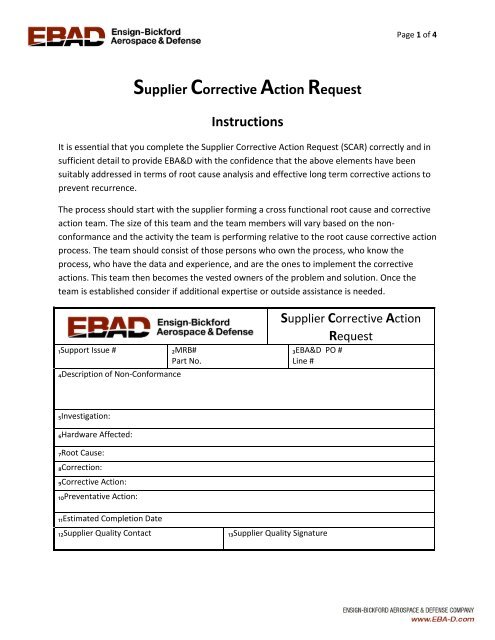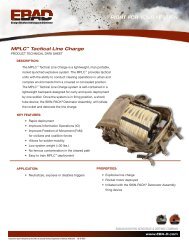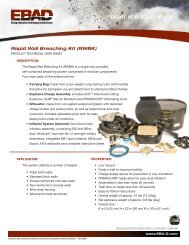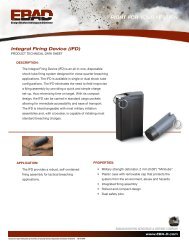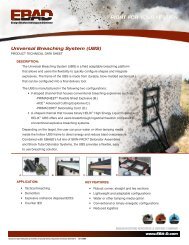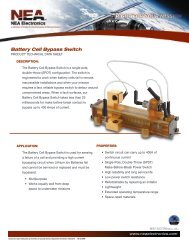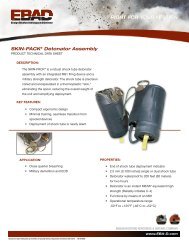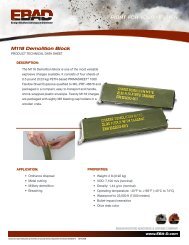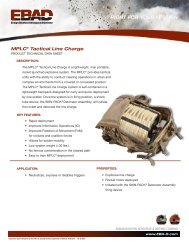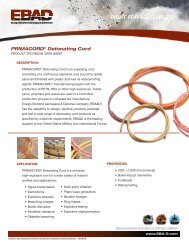Supplier Corrective Action Request Instructions
Supplier Corrective Action Request Instructions
Supplier Corrective Action Request Instructions
Create successful ePaper yourself
Turn your PDF publications into a flip-book with our unique Google optimized e-Paper software.
Page 2 of 4Block 1- Support Issue# - Enter the support issue number supplied with the SCAR notificationletter.Block 2- MRB # and Part No. - Enter the MRB number and Part Number supplied with the SCARnotification letter.Block 3- EBA&D P.O. # and Line item # - Enter the EBA&D purchase order number and line itemof the PO the nonconforming material was delivered against.Block 4- Description of Non-Conformance - Provide a description of the non-conformanceidentified in the Material Review Board (MRB).Block 5- Investigation - Upon receipt of a SCAR from EBA&D, an investigation must becompleted by the supplier to validate the non-conformance. This investigation may becomprised of reviewing raw materials used, reviewing build paperwork, dimensionalinspections, etc. to understand why the non-conformance exists so that a problem definitioncan be identified. In order to investigate and correct a problem, it must be clearly andappropriately defined.Block 6- Hardware Affected - The supplier is to determine if any level of containment is neededand evaluate the product in-process, in-stock, in transit, or at EBA&D. The supplier mustdetermine how much product was found to contain this non-conformance and how muchproduct may potentially contain this non-conformance.Block 7- Root Cause - The supplier is to determine the underlying reason for thenoncompliance. Both the process root cause (causing the product nonconformance) andQuality system root cause (reason the variance was not detected and escaped the supplier’sfacility) should be analyzed. The factual information and data necessary to assure a thoroughcause analysis needs to be collected. The preferred list of quality tools to be used to perform aroot cause investigation includes, but is not limited to the following:Process FlowchartingCause and Effect Diagram (Fishbone)Decision MatrixPareto AnalysisKaizen eventBrainstorming5 “Why” Method Statistical Process ControlPlan-Do-Check-Act
Page 3 of 4EBA&D would like to know the problem solving method used to determine the root cause ofthis nonconformance. Only the identified root cause(s) should be included on the response tothe SCAR including details of how the cause was identified. Supplemental information tosupport the cause analysis may be included as objective evidence if necessary forunderstanding or clarification. EBA&D can provide training on root cause analysis if desired. Torequest training contact your EBA&D Buyer.Block 8- Correction - The supplier is to determine what is required to correct the existing nonconforming material completed ,in process or in shipment. (Screen, Rework, Replace, etc)Block 9- <strong>Corrective</strong> <strong>Action</strong> - The supplier is to detail the steps necessary to successfullygenerate corrective action(s) needed to contain the process from allowing nonconformingmaterial to escape their facility, or to be otherwise used inadvertently.Improved tooling, fixturing, gaging, etc.Modify and better defined manufacturing process.Revised manufacturing operation instruction sheet to clarify and better define workinstructions.Conduct formal and informal on the job training.Revise measurement system or where in the process the measurement is taken.Any documents or processes that have been modified must be included in this section of theSCAR and have EBA&D approval before implementation. This is needed to determine if apreviously qualified process will need to be re-qualified.Block 10- Preventative <strong>Action</strong> - The supplier shall determine what preventative action shouldbe evaluated and implemented if necessary. The preventative action may be a long termcorrective action, such as a new piece of equipment that will preclude a nonconformance. Itshould be considered to be a proactive undertaking action to eliminate the cause of a potentialnonconformance. Preventative action may be in the form of trend (or statistical) analysis or anevaluation of nonconformities that have occurred in similar circumstances, but for otherproducts, processes, or other parts of the organization. Another form of preventative actionwould be a PFEMA to determine what can go wrong and implement a cure for the situation.


